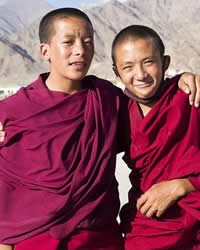Ladakhi in China

Photo Source:
Christopher Michel - Flickr
Creative Commons
|
Send Joshua Project a map of this people group.
|
| People Name: | Ladakhi |
| Country: | China |
| 10/40 Window: | Yes |
| Population: | 600 |
| World Population: | 600 |
| Primary Language: | Ladakhi |
| Primary Religion: | Buddhism |
| Christian Adherents: | 0.00 % |
| Evangelicals: | 0.00 % |
| Scripture: | New Testament |
| Ministry Resources: | Yes |
| Jesus Film: | Yes |
| Audio Recordings: | Yes |
| People Cluster: | Tibeto-Burman, other |
| Affinity Bloc: | Tibetan-Himalayan Peoples |
| Progress Level: |
|
Introduction / History
Leh, the capital of Ladakh, was the home of an independent Ladakhi monarchy for a thousand years. Today, a Ladakhi royal family still exists in Leh, but their influence has been merely symbolic since India's independence in 1947. The Ladakhi in China are a Tibetan group, but they have major linguistic and historical differences from their counterparts in Tibet. The closely related Nubra people group also live in China.
What Are Their Lives Like?
Life for the Ladakhi is hard because of their remote location in the mountains. Farmers rely on melted snow to water their crops. Winter temperatures remain constant at minus 30C (-22F).
What Are Their Beliefs?
The Ladakhi share the beliefs of their Tibetan neighbors. Tibetan Buddhism, mixed with images of ferocious demons from the pre-Buddhist Bon religion, has been the stronghold in Ladakh for more than a thousand years. Traces of influence from the dark, distant past are found in the demonic masks and reenactments of human sacrifices that make up their festivals. The Ladakhi believe hell is a miserably cold place.
The first Christians to the Ladakhi were probably Nestorian traders in the eighth century. There are no known Christians among the small number of Ladakhi in Tibet.
What Are Their Needs?
The Ladakhi people need Jesus as the true guide for their families and communities. They need to know their purpose; to love God with all their hearts, minds and souls.
Prayer Points
Pray for God s divine intervention in this community to know and accept Christ as their Lord.
Pray they understand Jesus is the only way to truth and salvation.
Pray for God to soften their hearts and to know that Jesus is the way, the truth, and the life.
Pray for many Christian communities to grow in their location to show them the blessings of a Christ-centered life.